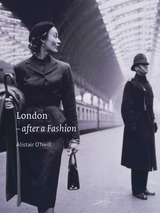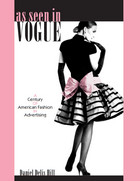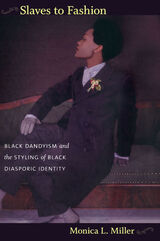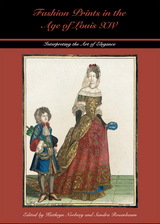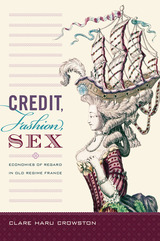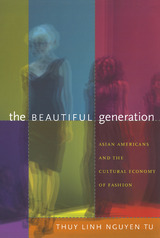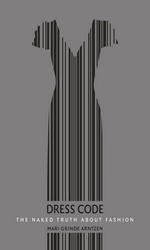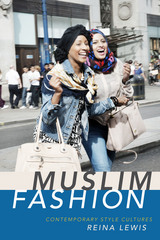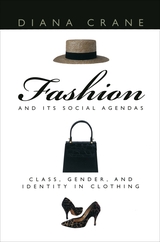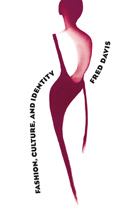FashionCollection by Cassandra Verhaegen (10 items)Reading in style. Includes the following tags:
After, Asian Americans, Century, Class, Clothing and dress, Clothing trade, Corporate & Business History, Crafts & Hobbies, Fashion, Fashion & Accessories, Gender identity, Group identity, London, Pierce, Kerri, Slaves, Turkey
See More
|
London
by Alistair O'Neill
Reaktion Books, 2007
London Fashion Week is the pinnacle of the fashion season, and it features an array of native designers, from Burberry and Vivenne Westwood to Alexander McQueen and Nicole Farhi. The roots of London’s place as the international epicenter of haute couture and prêt-à-porter stretch back centuries, and they are explored here by Alistair O’Neill. Arguing that fashion was central to the impact of modernity in late nineteenth- and twentieth-century London, O’Neill maps the progress of fashion against the city’s neighborhoods and streets. Carnaby Street, Soho, Jermyn Street, and King’s Road each get their turn in London, along with many others, revealing the intersection between London’s urban history and the development of fashion. O’Neill’s analysis is not merely confined to clothing—from the popularity of tattooing in the 1890s to the diverse uses of chintz in the 1980s design aesthetic, he traces the history of fashion in its various manifestations and explores how particular figures were key to disseminating fashion throughout British and international cultures. Participating in fashion, Londonshows, was not only a pleasurable aspect of modern urban life, but also a fundamental element of contemporary cultural sensibilities. London unearths vital moments of revolution in fashion that reflect deeper changes in London’s history and culture, contending that these historic changes are unfairly marginalized in accounts of transformation in the city’s culture. A fascinating look at style and urbanism, London offers an intriguing reconsideration of the role of fashion in city life and fills in long overlooked gaps in the history of London and modern design.
1
|
As Seen in Vogue
by Daniel Delis Hill
Texas Tech University Press, 2004
Throughout the twentieth century the ready-to-wear industry, fashion journalism, and mass-media advertising fueled one another’s success by identifying an ever-widening consumer class and fanning the desire to be fashionable. Through more than six hundred fashion ads that appeared in Vogue from the magazine’s debut in 1893 through the next ten decades, Hill documents not only this symbiosis but also an evolution in American fashion, society, and culture.In rich progression, the images document metamorphoses: from alabaster Victorian homemaker to painted flapper in just a generation, from conformist fifties mom to miniskirt-clad iconoclast only a decade later, from power-suited yuppie of the eighties to the techno self-stylist of the new millennium. In this long view of interactions that shaped much, much more than the fashion, Hill offers a comprehensive examination and resource for students and professionals in fashion and business history, popular culture, advertising, marketing, and women’s studies.
2
|
Slaves to Fashion
by Monica L. Miller
Duke University Press, 2009
Slaves to Fashion is a pioneering cultural history of the black dandy, from his emergence in Enlightenment England to his contemporary incarnations in the cosmopolitan art worlds of London and New York. It is populated by sartorial impresarios such as Julius Soubise, a freed slave who sometimes wore diamond-buckled, red-heeled shoes as he circulated through the social scene of eighteenth-century London, and Yinka Shonibare, a prominent Afro-British artist who not only styles himself as a fop but also creates ironic commentaries on black dandyism in his work. Interpreting performances and representations of black dandyism in particular cultural settings and literary and visual texts, Monica L. Miller emphasizes the importance of sartorial style to black identity formation in the Atlantic diaspora.
Dandyism was initially imposed on black men in eighteenth-century England, as the Atlantic slave trade and an emerging culture of conspicuous consumption generated a vogue in dandified black servants. “Luxury slaves” tweaked and reworked their uniforms, and were soon known for their sartorial novelty and sometimes flamboyant personalities. Tracing the history of the black dandy forward to contemporary celebrity incarnations such as Andre 3000, Miller explains how black people became arbiters of style and how they have historically used the dandy’s signature tools—clothing, gesture, and wit—to break down limiting identity markers and propose new ways of fashioning political and social possibility in the black Atlantic world. With an aplomb worthy of her iconographic subject, she considers the black dandy in relation to nineteenth-century American literature and drama, W. E. B. Du Bois’s reflections on black masculinity and cultural nationalism, the modernist aesthetics of the Harlem Renaissance, and representations of black cosmopolitanism in contemporary visual art.
3
|
Fashion Prints in the Age of Louis XIV
edited by Kathryn Norberg and Sandra Rosenbaum
Texas Tech University Press, 2014
Re-examining seventeenth-century French style
Between 1678 and 1710, Parisian presses printed hundreds of images of elegantly attired men and women dressed in the latest mode, and posed to display every detail of their clothing and accessories. Long used to illustrate dress of the period, these fashion prints have been taken at face value and used uncritically. Drawing on perspectives from art history, costume history, French literature, museum conservation and theatrical costuming, the essays in this volume explore what the prints represent and what they reveal about fashion and culture in the seventeenth century. With more than one hundred illustrations, Fashion Prints in the Age of Louis XIV constitutes not only an innovative analysis of fashion engravings, but also one of the most comprehensive collections of seventeenth-century fashion images available in print.
4
|
Credit, Fashion, Sex
by Clare Haru Crowston
Duke University Press, 2013
In Old Regime France credit was both a central part of economic exchange and a crucial concept for explaining dynamics of influence and power in all spheres of life. Contemporaries used the term credit to describe reputation and the currency it provided in court politics, literary production, religion, and commerce. Moving beyond Pierre Bourdieu's theorization of capital, this book establishes credit as a key matrix through which French men and women perceived their world. As Clare Haru Crowston demonstrates, credit unveils the personal character of market transactions, the unequal yet reciprocal ties binding society, and the hidden mechanisms of political power. Credit economies constituted "economies of regard" in which reputation depended on embodied performances of credibility. Crowston explores the role of fashionable appearances and sexual desire in leveraging credit and reconstructs women's vigorous participation in its gray markets. The scandalous relationship between Queen Marie Antoinette and fashion merchant Rose Bertin epitomizes the vertical loyalties and deep social divides of the credit regime and its increasingly urgent political stakes.
5
|
The Beautiful Generation
by Thuy Linh Nguyen Tu
Duke University Press, 2011
Since the 1990s, young Asian Americans including Doo-Ri Chung, Derek Lam, Thakoon Panichgul, Alexander Wang, and Jason Wu have emerged as leading fashion designers. They have won prestigious awards, been chosen to head major clothing labels, and had their designs featured in Vogue, Harper’s Bazaar, and other fashion magazines. At the same time that these designers were rising to prominence, the fashion world was embracing Asian chic. During the 1990s, “Asian” shapes, fabrics, iconography, and colors filled couture runways and mass-market clothing racks. In The Beautiful Generation, Thuy Linh Nguyen Tu explores the role of Asian American designers in New York’s fashion industry, paying particular attention to how they relate to the garment workers who produce their goods and to Asianness as a fashionable commodity. She draws on conversations with design students, fashion curators, and fashion publicists; interviews with nearly thirty Asian American designers who have their own labels; and time spent with those designers in their shops and studios, on their factory visits, and at their fashion shows. The Beautiful Generation links the rise of Asian American designers to historical patterns of immigration, racial formation, and globalized labor, and to familial and family-like connections between designers and garment workers.
6
|
Dress Code
by Mari Grinde Arntzen
translated by Kerri Pierce Reaktion Books, 2015
As Oscar Wilde once wrote, “Fashion is a form of ugliness so absolutely unbearable that we have to alter it every six months.” And yet it serves to make us beautiful, or at least make us feel beautiful. In this book, Mari Grinde Arntzen asks how and why this is—how can fashion simultaneously attract us to its glamour and repel us with its superficiality and how being called “fashionable” can be at once a compliment and an insult. Arntzen guides us through the major figures and brands of today’s fashion industry, showing how they shape us and in turn why we love to be shaped by them. She examines both everyday, affordable “fast fashion” brands, as well as the luxury market, to show how fashion commands a powerful influence on every socioeconomic level of our society. Stepping into our closets with us, she thinks about what happens when we get dressed: why fashion can make us feel powerful, beautiful, and original at the same time that it forces us into conformity. Stripping off the layers of the world’s fifth largest industry, garment by garment, she holds fashion up as a phenomenon, business, and art, exploring the questions it forces us to ask about the body, image, celebrity, and self-obsession. Ultimately, Arntzen asks the most direct question: what is fashion? How has it taken such a powerful hold on the world, forever propelling us toward its concepts of beauty?
7
|
Muslim Fashion
by Reina Lewis
Duke University Press, 2015
In the shops of London's Oxford Street, girls wear patterned scarves over their hair as they cluster around makeup counters. Alongside them, hip twenty-somethings style their head-wraps in high black topknots to match their black boot-cut trousers. Participating in the world of popular mainstream fashion—often thought to be the domain of the West—these young Muslim women are part of an emergent cross-faith transnational youth subculture of modest fashion. In treating hijab and other forms of modest clothing as fashion, Reina Lewis counters the overuse of images of veiled women as "evidence" in the prevalent suggestion that Muslims and Islam are incompatible with Western modernity. Muslim Fashion contextualizes modest wardrobe styling within Islamic and global consumer cultures, interviewing key players including designers, bloggers, shoppers, store clerks, and shop owners. Focusing on Britain, North America, and Turkey, Lewis provides insights into the ways young Muslim women use multiple fashion systems to negotiate religion, identity, and ethnicity.
8
|
Fashion and Its Social Agendas
by Diana Crane
University of Chicago Press, 2000
It has long been said that clothes make the man (or woman), but is it still true today? If so, how has the information clothes convey changed over the years? Using a wide range of historical and contemporary materials, Diana Crane demonstrates how the social significance of clothing has been transformed. Crane compares nineteenth-century societies—France and the United States—where social class was the most salient aspect of social identity signified in clothing with late twentieth-century America, where lifestyle, gender, sexual orientation, age, and ethnicity are more meaningful to individuals in constructing their wardrobes. Today, clothes worn at work signify social class, but leisure clothes convey meanings ranging from trite to political. In today's multicode societies, clothes inhibit as well as facilitate communication between highly fragmented social groups. Crane extends her comparison by showing how nineteenth-century French designers created fashions that suited lifestyles of Paris elites but that were also widely adopted outside France. By contrast, today's designers operate in a global marketplace, shaped by television, film, and popular music. No longer confined to elites, trendsetters are drawn from many social groups, and most trends have short trajectories. To assess the impact of fashion on women, Crane uses voices of college-aged and middle-aged women who took part in focus groups. These discussions yield fascinating information about women's perceptions of female identity and sexuality in the fashion industry. An absorbing work, Fashion and Its Social Agendas stands out as a critical study of gender, fashion, and consumer culture. "Why do people dress the way they do? How does clothing contribute to a person's identity as a man or woman, as a white-collar professional or blue-collar worker, as a preppie, yuppie, or nerd? How is it that dress no longer denotes social class so much as lifestyle? . . . Intelligent and informative, [this] book proposes thoughtful answers to some of these questions."-Library Journal
9
|
Fashion, Culture, and Identity
by Fred Davis
University of Chicago Press, 1992
What do our clothes say about who we are or who we think we are? How does the way we dress communicate messages about our identity? Is the desire to be "in fashion" universal, or is it unique to Western culture? How do fashions change? These are just a few of the intriguing questions Fred Davis sets out to answer in this provocative look at what we do with our clothes—and what they can do to us. Much of what we assume to be individual preference, Davis shows, really reflects deeper social and cultural forces. Ours is an ambivalent social world, characterized by tensions over gender roles, social status, and the expression of sexuality. Predicting what people will wear becomes a risky gamble when the link between private self and public persona can be so unstable.
10
|
| Click here to go to the beginning. | ||||||||||
